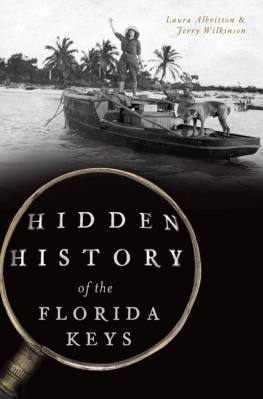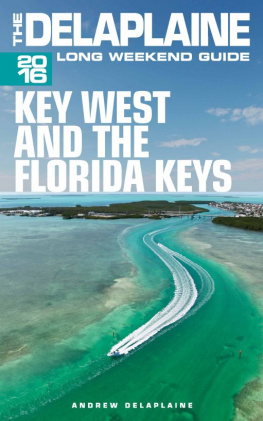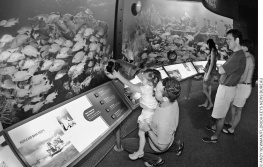

Published by The History Press
Charleston, SC
www.historypress.com
Copyright 2018 by Laura Albritton and Jerry Wilkinson
All rights reserved
Front cover image courtesy of the Monroe County Public Library, Key West.
First published 2018
E-Book edition 2018
ISBN 9781439665701
Library of Congress Control Number: 2018948029
Print edition ISBN 978.1.46713.891.8
Notice: The information in this book is true and complete to the best of our knowledge. It is offered without guarantee on the part of the authors or The History Press. The authors and The History Press disclaim all liability in connection with the use of this book.
All rights reserved. No part of this book may be reproduced or transmitted in any form whatsoever without prior written permission from the publisher except in the case of brief quotations embodied in critical articles and reviews.
For Tom Hambright, with thanks.
CONTENTS
ACKNOWLEDGEMENTS
The authors would like to thank historian Tom Hambright and archivist Breana Sowers of the Monroe County Library at Key West for their help in researching this book. Tom provided particularly useful background on the Old Island Restoration Foundation. They are also grateful that they could use several photographs from the Monroe County Librarys archive. The assistance of Mark Nicolou, Kathryn Palmer, Jacklyn Attaway and Adam Watson in obtaining research materials and images from the State Archives of Florida was much appreciated. For permission to use images from the Edwin A. and Marion C. Link Collection, they thank the John H. Evans Library at the Florida Institute of Technology and Diane Newman, Special Collections curator. Thanks also go to the Key West Literary Seminar for awarding Laura a writers residency and to Arlo Haskell and Freya Hendrickson for their kind welcome. Laura also thanks Trudy Hale for a productive writing retreat at the Porches and writer Lisa Hartz for her friendship and encouragement. The authors additionally wish to express their gratitude to everyone at The History Press who made this book possible, including Acquisitions Editors Amanda Irle and Mike Kinsella and Senior Editor Ryan Finn. Last but certainly not least, their most heartfelt gratitude goes out to Zickie Allgrove and Mary Lou Wilkinson.
INTRODUCTION
The Florida Keys lie scattered in a graceful arc that extends from the southeast Florida mainland all the way to the Dry Tortugas. At one time, they were remote outposts where seabirds far outnumbered human beings; untouched reefs with brightly colored corals teemed with fish, and dense mangroves lined the shores. While these islands are not especially large (with an area of only 137 square miles), their beauty and the splendor of the surrounding ocean rarely fail to make an impression on those fortunate enough to see them in person. As pioneers from the Americas and Europe began settling here, they transformed the Florida Keys, yet the Keys also transformed them. The obscurity of the location; the unpredictable, tropical weather; and the unique customs and manners that developed over time would mold the settlers into a new breed of Floridian: the Conchs.
From the time of the earliest settlements, Florida Keys history has abounded with outsized adventures, strange events, colorful characters and, of course, natural disasters. It was inevitable that writers and historians would want to chronicle this history, and so they have, in a surprisingly rich abundance of books and articles. This wealth of publication presented the two of us as authors with a conundrum: Could we locate enough hidden history to warrant a new book?
Fortunately, one of us (Jerry Wilkinson) has spent decades collecting records, photographs and ephemera that document Florida Keys heritage. Although Jerry has generously shared his expertise in book form, on film, on his extensive website and during hundreds of presentations, there were still episodes he had researched, such as the Key West Extension scare, that could be included in this project. The quest to identify even more hidden history sent another one of us (Laura Albritton) to the Key West librarys magical archives to discover stories from the Prohibition era and to investigate the islands early historic preservation movement.
In the end, our books scope spans 140 years, from the 1820s to the 1960s. In the following ten chapters, you will encounter duelists, soldiers, politicians, pioneers, rumrunners, writers, exotic dancers and historic preservationists. They are, without a doubt, a lively and unusual cast of historic figures. There are vast differences in their backgrounds and socioeconomic situations, not to mention their standards of morality. Nevertheless, the people who lived these stories did have qualities in common: courage, an adventurous spirit and an uncompromising individualism.
Another question emerged as we discussed subjects to cover in the book: Exactly how hidden did these hidden histories need to be? Should the history be utterly unheard of or just somewhat lesser known? In the end, we decided to include certain subjects that we hope will surprise even fervent Florida Keys history buffs, in addition to narratives that are less obscure. In some cases, we took subjects that had already been briefly written about (including by ourselves in previous books) and dug further to provide readers with a more detailed understanding of past events. In writing about Adderley Town, in particular, we knew that Marathon residents and Crane Museum visitors would be familiar with the basic story; however, our sense was that outside the Middle Keys, the Adderleys achievement deserves to be more widely recognized. Finally, in order to make the book accessible to as many readers as possible, we have given historical context and background in each chapter. Whether you have read multiple volumes on Keys history or know next to nothing about the Florida Keys, we hope that you find these ten accounts an illuminating and enjoyable read.
CHAPTER 1
PISTOLS AT DAWN
On a cool February evening in 1829, Captain Charles Hawkins would have called good night to his fellow dinner guests at Ellen Mallorys boardinghouse and lurched out onto the unpaved Key West street. The small town of barely five hundred souls stood hunkered on the northern edge of the island, its house windows illuminated by candlelight and oil lamps. Captain Hawkins most likely carried a torch, for the road was uneven and dark, and especially after such a convivial night, he would have had to watch his step. Little entertainment existed on the remote island outpost, which, as one resident recalled, naturally led to long sittings over the wine cup at the dinner table of the only general boarding house.
Something odd about his return home may have made Hawkins suspicious. Perhaps it was the windows of the house that appeared uncharacteristically dark or the fact that his wife did not greet him at the door. On reaching his house at a late hour, he would have needed to use the torch to see the door latch and let himself inside, where his boots echoed across the sturdy timber floor.

Ellen Mallorys boardinghouse, where Captain Charles Hawkins dined with other Key West residents. Courtesy of the Monroe County Public Library, Key West.
But it was too late. The young lover had escaped. Peering through the window, the captain would have realized that there was no chance of catching the young man sprinting into the night. What next transpired between husband and wife we can only surmise. Hawkinss temper must have come into play, as he turned on Mrs. Hawkins, possibly shouting, she perhaps sobbing, as he demanded to know what in Gods name had she been doing with that scoundrel attorney. The evening, which began so pleasantly for him with the dinner at Ellen Mallorys boardinghouse, would culminate in one of the most disquieting chapters in Florida Keys history.
Next page








